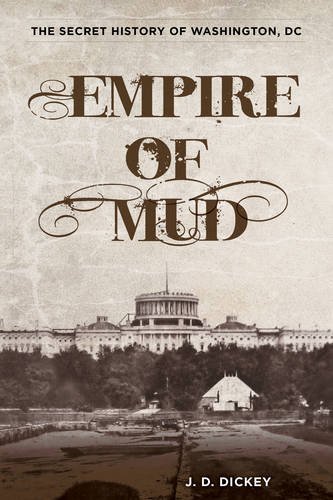
Empire of Mud
The Secret History of Washington, DC
کتاب های مرتبط
- اطلاعات
- نقد و بررسی
- دیدگاه کاربران
نقد و بررسی

July 7, 2014
Certain adjectives spring to mind when reading this eye-opening, in-depth look at the history of America’s capital city in the 19th century: sordid, squalid, tawdry, filthy, and corrupt. Dickey (The Rough Guide to Washington, DC) pulls no punches as he examines the dark side of the District’s misspent youth, from its origins as a compromise carved from several states to its evolution into “a fiefdom ruled by national politicians”—one whose “citizens were denied the right to vote for those politicians.” Dickey covers every vice: murder, mayhem, political infighting, prostitution, incompetence, greed, dueling, slavery, and of course, war. Given the bleak portrait he paints of a city perpetually on the edge of chaos, where gangs clash and crime flourishes, where disease runs rampant, where civic projects and grandiose plans languish for decades, it’s amazing that the city survived long enough to endure its slow transformation into a real city—albeit one lacking certain rights and representation. Even as Dickey expresses a wistful nostalgia for long-vanished neighborhoods, he bemoans the District’s unique political nature. Only someone who loves the city can be so honest about its flaws, and this love shows in Dickey’s flowing style and knowledgeable approach. Agent: Jason Allen Ashlock, Movable Type Management.

September 1, 2014
While colloquially referred to Washington, DC or simply DC, the formal name for our capital city is the District of Columbia. How did this come about? As Dickey (The Rough Guide to Washington, DC) explains, a city of Washington existed from 1802 until Congress abolished it in 1871 and consolidated it into the District of Columbia. The author focuses on that old city, which was little more than a swampy, small town few could wait to flee when Congress was not in session. Dickey brings the place to life, relating how it came to be the national capital and how it looked, felt, and functioned. His 11 chapters identify the area's early movers and shakers, touring from the 1790s to the 1870s to reimagine a city in formation. It was no urban showplace or splendid citadel but a raucous, ramshackle collection of chaotic markets complete with slave depots, taverns, bordellos, and gambling houses set among streets that were often caked with mud owing to the persistent damp. VERDICT An entertaining story for local history enthusiasts or general readers eager to peek into the curiosities and scandals in the less-than-reputable past of the now glittering capital. --Thomas J. Davis, Arizona State Univ., Tempe
Copyright 2014 Library Journal, LLC Used with permission.

August 1, 2014
So many large American cities evolved haphazardly over the course of centuries. Their origins, often shrouded in myths or legends, may be traced back to Native American meeting sites, primitive trading centers, or rudimentary agricultural settlement. In tracking the development of Washington, D.C., in the nineteenth and twentieth centuries, Dickey repeatedly stresses how the capital was different. This is an engrossing, revealing, but relentlessly depressing account of urban founding and development. According to Dickey, members of the Confederation Congress, frightened by threats from disgruntled military units around Philadelphia, saw the necessity to establish a more distant and secure capital. The Residence Act of 1790, a result of political horse trading between Thomas Jefferson and Alexander Hamilton, determined a more precise location. Dickey effectively illustrates the political and social instability that surrounded the construction of the city. As the city slowly expanded, it was fertile ground for greedy speculators, hordes of corrupt businessmen, and prostitutes. Dickey probably overemphasizes the original sin aspect of the foundation and subsequent development, but this is a useful if slanted account of the development of our capital.(Reprinted with permission of Booklist, copyright 2014, American Library Association.)

























دیدگاه کاربران